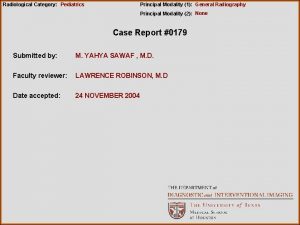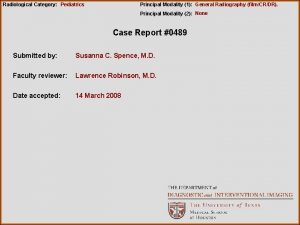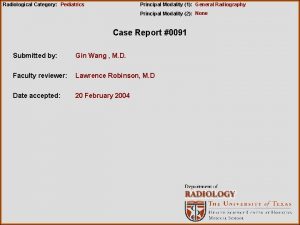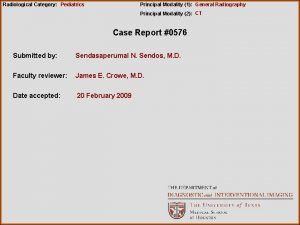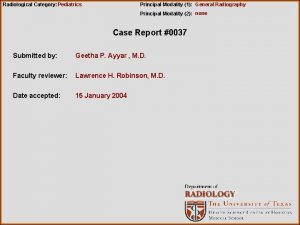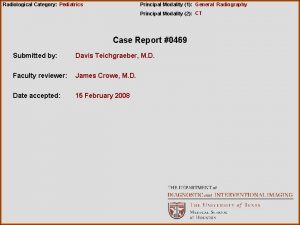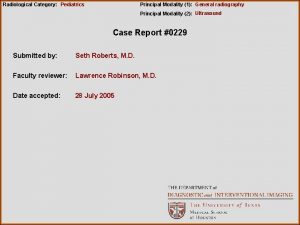Radiological Category Pediatrics Principal Modality 1 General Radiography











- Slides: 11

Radiological Category: Pediatrics Principal Modality (1): General Radiography Principal Modality (2): MRI Case Report #0438 Submitted by: Supreet Singh, MD Faculty reviewer: Victor Seghers, MD Date accepted: 09 January 2008

Case History 5 month infant of Pakistani descent with multiple skin lesions and asymmetric overgrowth of the right lower extremity.

Radiological Presentations

Radiological Presentations STIR CORONAL MRI

Radiological Presentations AXIAL TI MRI

Radiological Presentations MRI 2 D VENOGRAM

Test Your Diagnosis Which one of the following is your choice for the appropriate diagnosis? After your selection, go to next page. • Hemihypertrophy • Klippel-Trenaunay-Weber Syndrome • Proteus Syndrome • Kaposiform Hemangioendothelioma

Findings and Differentials Findings: The first image demonstrates prominent soft tissue overgrowth, with normal bony anatomy. The STIR coronal MRI image demonstrates prominent asymmetry between the right and left lower extremity. There is prominently increased T 2 signal in the hypertrophied subcutaneous tissues. The Axial T 1 MR sequences and the 2 D venogram demonstrates the absence of the deep venous system on the right, with prominent venous collaterals, including the large marginal vein of Servelle. Differentials: • Hemihypertrophy • Klippel-Trenaunay-Weber Syndrome • Proteus Syndrome • Kaposiform Hemangioendothelioma

Diagnosis Klippel-Trenaunay-Weber Syndrome

Discussion Klippel-Trenaunay-Weber syndrome is characterized by the cutaneous vascular malformations, congenital vascular and lymphatic abnormalities and limb hypertrophy. Parkes Weber syndrome is similar except it involves the presence of AV malformations in addition to the cutaneous capillary malformation, deep venous system abnormalities and soft tissue hypertrophy. As seen in this patient, the limb hypertrophy is secondary to the presence of multiple venolymphatic malformations in the deep tissues, including the absence of the deep venous system in the right lower extremity (note absence of the superficial femoral or popliteal veins), with extensive collateralization. It has been postulated that the venous hypertension produced by the collateral vessels leads to hypertrophy. Over 90% of cases involve the lower extremities. Of the affected extremity, in onethird of the cases the entire extremity is involved.

Discussion At birth only the cutaneous lesions may be visible. Hypertrophic changes in the limbs develop as the child grows. Clinically, lymphatic involvement result is poor wound healing, deep vein thrombosis, pulmonary embolism. Surgical intervention is avoided when possible due to poor wound healing.
 Pa erate
Pa erate Tennessee division of radiological health
Tennessee division of radiological health Center for devices and radiological health
Center for devices and radiological health National radiological emergency preparedness conference
National radiological emergency preparedness conference Radiological dispersal device
Radiological dispersal device Modality in software engineering
Modality in software engineering Deontic and epistemic modality exercises
Deontic and epistemic modality exercises Modality in software engineering
Modality in software engineering Cardinality and modality in database
Cardinality and modality in database Modality
Modality Skill focus: persuasion
Skill focus: persuasion Pacs modality workstation
Pacs modality workstation












